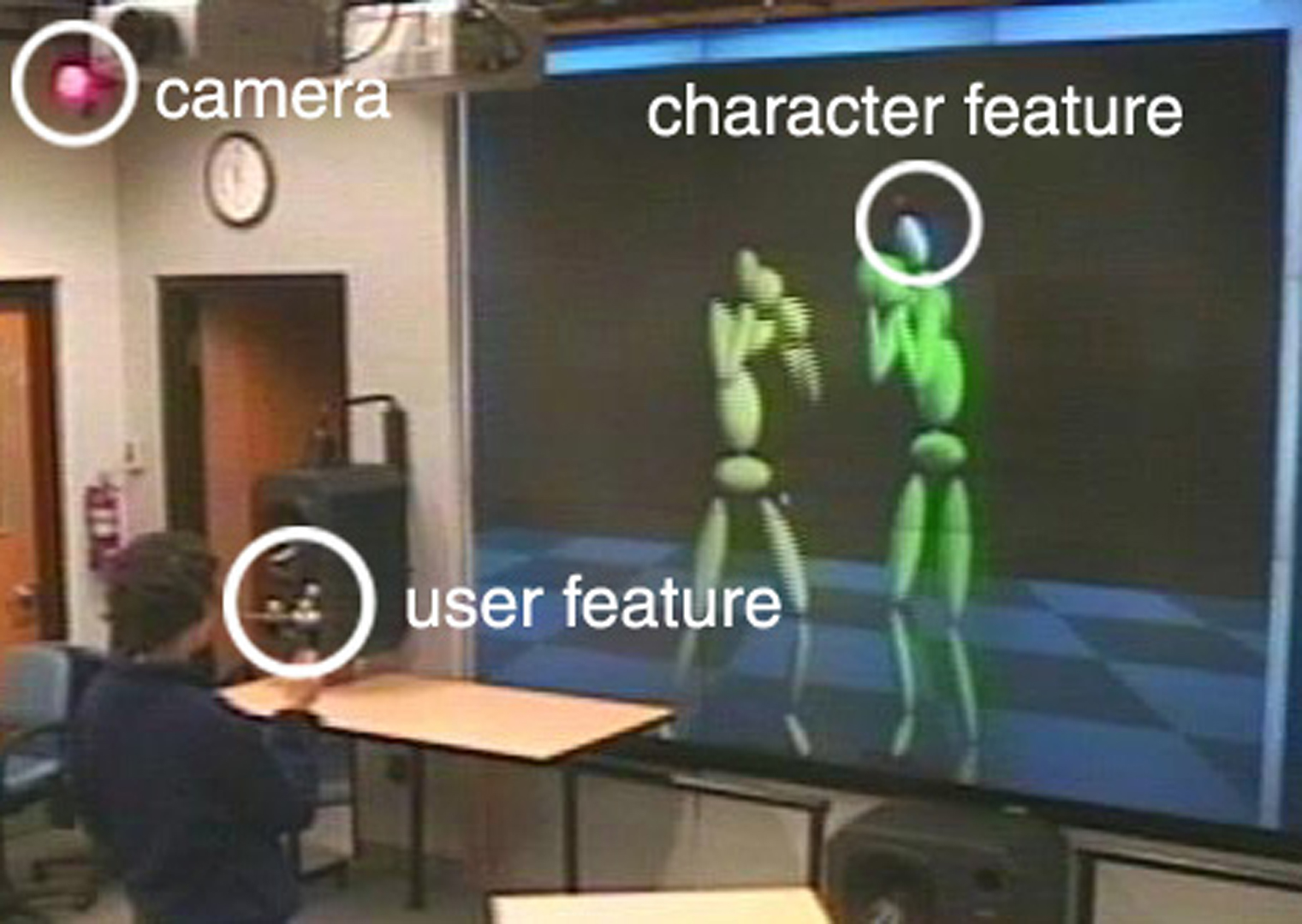“Layered acting for character animation” by Dontcheva, Yngve and Popovic
Conference:
Type(s):
Title:
- Layered acting for character animation
Presenter(s)/Author(s):
Abstract:
We introduce an acting-based animation system for creating and editing character animation at interactive speeds. Our system requires minimal training, typically under an hour, and is well suited for rapidly prototyping and creating expressive motion. A real-time motion-capture framework records the user’s motions for simultaneous analysis and playback on a large screen. The animator’s real-world, expressive motions are mapped into the character’s virtual world. Visual feedback maintains a tight coupling between the animator and character. Complex motion is created by layering multiple passes of acting. We also introduce a novel motion-editing technique, which derives implicit relationships between the animator and character. The animator mimics some aspect of the character motion, and the system infers the association between features of the animator’s motion and those of the character. The animator modifies the mimic by acting again, and the system maps the changes onto the character. We demonstrate our system with several examples and present the results from informal user studies with expert and novice animators.
References:
1. BENQUEY, V., AND JUPPE, L. 1997. The use of real-time performance animation in the production process. In ACM SIGGRAPH 97: Course Notes.Google Scholar
2. BORCHERS, J. O., SAMMINGER, W., AND M UHLAUSER, M. 2001. Conducting a realistic electronic orchestra. In ACM UIST 2001. Google ScholarDigital Library
3. DE GRAF, B., AND YILMAZ, E. 1999. Puppetology: Science or cult? Animation World 3, 11.Google Scholar
4. DE GRAF, B. 1989. Notes on human facial animation. In ACM SIGGRAPH 89: Course Notes.Google Scholar
5. DONALD, B. R., AND HENLE, F. 2000. Using haptic vector fields for animation motion control. In Proceedings of IEEE Int. Conf. on Robotics and Automation.Google ScholarCross Ref
6. GILDFIND, A., GIGANTE, M. A., AND AL-QAIMARI, G. 2000. Evolving performance control systems for digital puppetry. The Journal of Visualization and Computer Animation 11, 4, 169–183.Google ScholarCross Ref
7. IGARASHI, T., MATSUOKA, S., AND TANAKA, H. 1999. Teddy: A sketching interface for 3d freeform design. Proceedings of SIGGRAPH 99, 409–416. Google Scholar
8. JOHNSON, M. P., WILSON, A., KLINE, C., BLUMBERG, B., AND BOBICK, A. 1999. Sympathetic interfaces: Using a plush toy to direct synthetic characters. In Proceedings of CHI, 152–158. Google Scholar
9. LASZLO, J., VANDE PANNE, M., AND FIUME, E. L. 2000. Interactive control for physically-based animation. Proceedings of SIGGRAPH 2000, 201–208. Google ScholarDigital Library
10. LEE, J., AND SHIN, S. Y. 2002. General construction of time-domain filters for orientation data. IEEE Transactions on Visualization and Computer Graphics 8, 2, 119–128. Google ScholarDigital Library
11. MARDIA, K. V., KENT, J. T., AND BIBBY, J. M. 2000. Multivariate Analysis. Academic Press.Google Scholar
12. OORE, S., TERZOPOULOS, D., AND HINTON, G. 2002. Local physical models for interactive character animation. Computer Graphics Forum 21, 3, 337–346.Google ScholarCross Ref
13. PERLIN, K. 1995. Real time responsive animation with personality. IEEE Transactions on Visualization and Computer Graphics 1, 1, 5–15. Google ScholarDigital Library
14. POPOVIĆ Z., AND WITKIN, A. P. 1999. Physically based motion transformation. Proceedings of SIGGRAPH 99, 11–20. Google Scholar
15. POPOVIĆ J., SEITZ, S. M., ERDMANN, M., POPOVIĆ, Z., AND WITKIN, A. P. 2000. Interactive manipulation of rigid body simulations. Proceedings of SIGGRAPH 2000, 209–218. Google ScholarDigital Library
16. PULLEN, K., AND BREGLER, C. 2000. Animating by multi-level sampling. Computer Animation 2000, 36–42. Google ScholarDigital Library
17. RAMSAY, J. O., AND SILVERMAN, B. W. 1997. Functional Data Analysis. Springer.Google Scholar
18. SCHKOLNE, S., PRUETT, M., AND SCHRÖDER, P. 2001. Surface drawing: Creating organic 3d shapes with the hand and tangible tools. In Proceedings of CHI 2001, 261–268. Google Scholar
19. SHIN, H. J., LEE, J., GLEICHER, M., AND SHIN, S. Y. 2001. Computer puppetry: An importance-based approach. ACM Transactions on Graphics 20, 2, 67–94. Google ScholarDigital Library
20. SNIBBE, S., AND LEVIN, G. 2000. Interactive dynamic abstraction. In Proceedings of NPAR, 21–29. Google ScholarDigital Library
21. STURMAN, D. J. 1998. Computer puppetry. Computer Graphics and Applications 18, 1, 38–45. Google ScholarDigital Library
22. WALTERS, G. 1989. The story of waldo c. graphic. In ACM SIGGRAPH 89: Course Notes.Google Scholar




